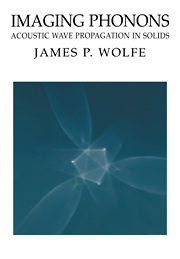Book contents
- Frontmatter
- Contents
- Preface
- Prologue – Anisotropic heat flow in crystals
- 1 Ballistic heat pulses and phonon imaging – A first look
- 2 Phonon focusing
- 3 Generation and detection of phonons – Experimental aspects
- 4 Focusing in cubic crystals
- 5 Acoustic symmetry and piezoelectricity
- 6 Lattice dynamics
- 7 Imaging of dispersive phonons
- 8 Phonon dynamics
- 9 Bulk scattering of phonons – Experiments
- 10 Quasidiffusion and the phonon source
- 11 Phonon scattering at interfaces
- 12 Refraction and reflection at solid/solid interfaces – Experiment
- 13 Imaging ultrasound in solids
- 14 Imaging surface acoustic waves
- 15 Interactions of ballistic phonons with electrons
- Appendix I Algebraic solution to the wave equation
- Appendix II Abbreviated tensor notation and group velocity
- Appendix III Survey of phonon focusing in cubic crystals
- Index
13 - Imaging ultrasound in solids
Published online by Cambridge University Press: 24 March 2010
- Frontmatter
- Contents
- Preface
- Prologue – Anisotropic heat flow in crystals
- 1 Ballistic heat pulses and phonon imaging – A first look
- 2 Phonon focusing
- 3 Generation and detection of phonons – Experimental aspects
- 4 Focusing in cubic crystals
- 5 Acoustic symmetry and piezoelectricity
- 6 Lattice dynamics
- 7 Imaging of dispersive phonons
- 8 Phonon dynamics
- 9 Bulk scattering of phonons – Experiments
- 10 Quasidiffusion and the phonon source
- 11 Phonon scattering at interfaces
- 12 Refraction and reflection at solid/solid interfaces – Experiment
- 13 Imaging ultrasound in solids
- 14 Imaging surface acoustic waves
- 15 Interactions of ballistic phonons with electrons
- Appendix I Algebraic solution to the wave equation
- Appendix II Abbreviated tensor notation and group velocity
- Appendix III Survey of phonon focusing in cubic crystals
- Index
Summary
This book could have been entitled “Phonon Caustics,” for it is these unusual concentrations of thermal energy resulting from point excitation of crystals that have provided a wealth of new perspectives on the physics of acoustic phonons. The concept of caustics, however, is not common to the parent field of physical acoustics. Why not? In large part, it is because acoustic experiments on solids usually employ planar sources of vibrational energy. Also, the coherence and macroscopic wavelengths of radio-frequency waves are not characteristics of nonequilibrium phonons. This chapter describes some recent ultrasonic-imaging experiments and calculations that help to establish the conceptual links between phonon imaging and physical acoustics. More importantly, we shall see that the extension of phonon-imaging techniques to ultrasound greatly expands the applicability of these methods.
Throughout the text we have used the word “acoustic” to designate the lowest branches of the vibrational spectrum – those waves which, in the limit of low frequency, have the same velocities and polarizations as sound waves in the solid. Indeed, many of the caustic patterns we have seen are predictable from continuum elasticity theory. Yet, we have implicitly assumed that the wavelengths of the phonons are smaller than the source and detector sizes, and certainly much smaller than the sample dimensions. This assumption is true even for the lowest frequencies observed in a typical heat-pulse experiment – approximately 100 GHz, corresponding to λ≃50 nm.
- Type
- Chapter
- Information
- Imaging PhononsAcoustic Wave Propagation in Solids, pp. 332 - 354Publisher: Cambridge University PressPrint publication year: 1998



